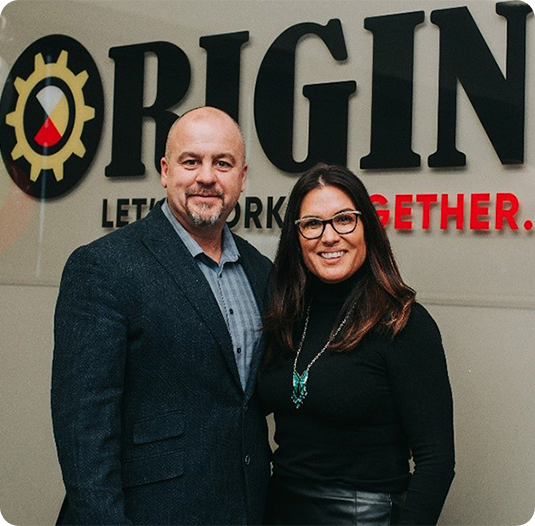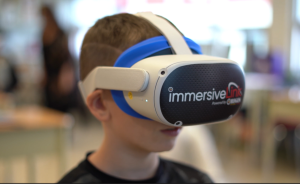Announcements
For press opportunities, please email info@immersivelink.ca.

Power of Technology in the Classroom
Technology is continuing to find integration into every aspect of our lives. This includes our classrooms. Recently our team visited an elementary school where we ran our ImmersiveLink 7 Career Ethics workshop. This made me realize how times are changing. Today, I’m going to share some insights I’ve picked up from this experience.
I’ll be covering:
Who is this applicable for?
While each student may come in with a different experience level, each one will have a level of understanding of how to use new technologies. Depending on the grade level, the types of technology and the frequency it’s integrated may vary.
Let’s look at how this could be applied to different grade levels.
For elementary, it can be simple. It may involve them getting used to the technology and learning how to handle it. The topics covered can remain high level and discussions around the content will happen outside of the VR experience.

Each workshop includes individual and group work exercises.
As you reach higher grade levels in secondary school, experiences can get more specific and have application components built into the experience. For example, with our ImmersiveLink 7 experience, students will go into the experience, interact with different elements that teach about each of the 7 Sacred Teachings and then complete the experience with a quiz.
I want to note that, like with our experience, these quiz elements have a download feature that allows you to extract student results!
Today I will be focusing the conversation on virtual reality (VR) technology. The great thing about VR is that it has effective elements for all learning styles:
students, it can be simple. It may involve them getting used to the technology and learning how to handle it. The topics covered can remain high level and discussions around the content will happen outside of the VR experience.
| Visual | Immersive visual content can improve the ability to conceptualize and understand applications. |
| Auditory | Sound elements can expand upon visuals and provide further context. |
| Kinesthetic | Interactive elements keep hands-on learners engaged and allow them to fully immerse themselves in the application. |
As teachers, your classroom’s make up is going to be a mix of all the above learning styles. I’m sure it can be challenging to find ways to support each student equally, which is where I think this technology can be a great fit. It allows facilitators to adapt to the needs of all their students without intensive planning and preparation.
What tools are needed? What does it look like?
Often, we will see schools have sets of technology that can be used by all the classrooms. First, we had computer labs, then Chromebooks and tablets, and now we see the VR headsets being brought in.

Student experiencing the ImmersiveLink 7 VR application.
Applications for Different Learning Styles
Dependent on the program you are looking to run, you’ll need to ensure that it runs on the devices your school has access to.
Benefits of integrating tech
This list continues to grow, I’m going to focus on areas we see benefit both students and teachers.
1. Engages students in a way that speaks to them
While it may not have always been this way, the use and integration of technology with today’s youth is huge. They have a good grasp on how to use the technology and see it as something fun and exciting. VR experiences are not a replacement for traditional teaching methods, but an extension of them that aligns with the interests of students.
2. Simplifies hard to understand concepts
As I mentioned earlier, VR technology is great for its ability to speak to those with all different learning styles. With different elements and functionality, experiences can simplify concepts that can be challenging to explain in typical lesson styles.
3. Provides access not otherwise accessible
From a cultural education perspective, I understand that teachers want to find ways to integrate this content into the curriculum but may not know the best way or feel comfortable teaching it themselves. With ImmersiveLink Cultural, teachers can feel comfortable knowing that the content is accurate and respects traditional protocols.
On the career side, ImmersiveLink Careers gives an inside look into worksites not accessible to the public. Especially with careers in the trades, it can be difficult to get a true understanding of the role from a simple job description. It also allows students to be exposed to career options that are not typically talked about.
Challenges
We recognize the challenges teachers face in terms of bandwidth and budget restrictions. Bringing in a new tool requires funds and time away from the students to understand how to use it and implement it. Common issues we hear from teachers we work with are around technology errors and finding ways to integrate it into the curriculum.
Technology Glitches
With all technology, we know there can always be glitches. With our products, you will always have access to our support team who are happy to help via email or phone call to get your app up and running in no time.
Integrating content into the classroom
Now I can’t speak to all the VR content available, but I can provide some insights into use cases for careers and cultural content. Teachers who use our content find them to be a great asset in Civics and Careers classes. The tool is often used for career exploration and planning. Some schools have even included the usage of this library as a micro-credit!

Snippet from the ImmersiveLink 7 teaching of love.
For the cultural content, teachers have integrated this into their social studies lessons to teach as part of Canada’s history and present-day culture.
Changes to come
The popularity of VR in the classroom is only continuing to rise. As the demand increases for these types of tools in the classroom, organizations, like us, will continue to work alongside teachers to see what features would make these tools even more effective.
Some of our in-house developments include additional interactivity, testing elements with a downloadable feature, complimentary workbooks and teaching guides (plus some other things that will have to stay secret for now 😉).
All this to say, we’re not here to replace traditional modes, but to support and take some of the workload off our hardworking teachers! If you’re still on the fence about how this technology could impact you and your students, don’t hesitate to reach out. Our team is happy to walk you through how we’ve seen it work for teachers and students across Ontario.
Let’s work. Together.
